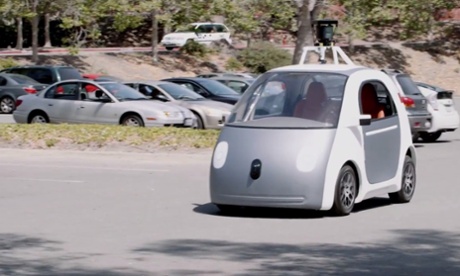Alright, this one’s kind of a biggie.
Google has created a self driving car, much to the chagrin of the motor vehicle establishment, safety regulators, Jeremy Clarkson (maybe) and frankly anyone else who enjoys driving.
Not to say that the undertaking isn’t huge and marvellously bold for a company that once built a search engine, although right now I’m writing on a Chromebook. Things have come a long way. Google’s self driving car is automated, uses sensors to detect obstacles and GPS to find its way around.
The utilitarian design is built not for looks, but more for safety. The front of the vehicle is ‘pedestrian friendly’ according to sources, and seems to be designed to either cave in or somehow deflect those unfortunate enough to cross the car’s path. With a top speed of 25mph minimising casualties might not be such a bad thing, as if you’re already going slowly you might as well lower the probability of injury as much as possible.
The media has been focusing on the efficiency of the car’s proximity sensor, with most sources concerned on whether it can detect small animals. Google says it hasn’t yet run tests, but the preliminary answer is no, your pets, badgers, squirrels and various other mammalian friends will not be safe from Google’s autonomous angel of death.
Google have a whole dedicated Google Self-Driving Car Project YouTube channel setup for the cars including the below Video showing off a first drive in the car.
The car will also be powered by electricity, although we haven’t heard whether it will have any kind of significant operating range just yet, and whether the sensors and satellite equipment will drain much of the stored power. The sensors are at the front of the car, and yes, the do create the image of a face, an intentional design feature, as it makes the car seem friendly, and (if you suffer from incredibly bad luck) it may very well be the last thing you ever see.
According to today’s paper, not many people have test-driven the device outside of Google, except some intrepid journalists from Recode, another tech site. They described the car as ‘a gondola with wheels’ and that it felt like ‘a theme park ride’ good to know, but the real question how does it drive? Apparently not the way you’re used to, as the car is controlled with the ultimate simplicity, a stop and go button. It may also use Google Maps to plan routes.
The car will come to Milton Keynes in the UK as soon as 2015, with 20 units arriving to serve as a ‘driverless public transport system’, the purpose of which is to give people mobility who otherwise would not be able to drive, like the elderly and disabled. Plus, if you’re really, really intoxicated, home is just a Google car away.
Steering wheels are included, and not just to soothe an already strained EU, but also to ensure that nothing goes wrong and manual control can be taken over if things go pear-shaped. Eventually, Google promises the cars will have no controls and be able to drive themselves. Whilst the driverless car is in itself illegal worldwide (mostly) Google is working closely with lawmakers to address this issue. One thing is clear though, and that’s that right now nothing is holding this project back. Revolutionary stuff, we’ll keep you updated when news arrives.
Tell us what you think of this self-driving machine, and whether you think it’s a disaster waiting to happen or a triumph of engineering below in the comments section.

